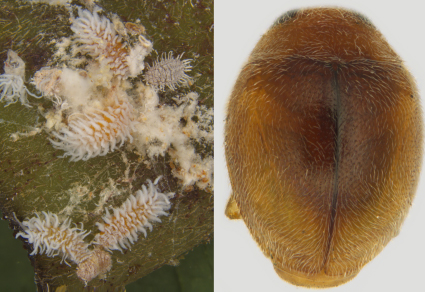Abstract
Several species of mealybugs infest various parts of bananas and plantains including foliage, fruits, rhizome and roots in all the major banana growing regions of India and cause moderate to occasionally serious damage but systematic attempts at documenting the mealybug pests of banana and their natural enemies are lacking in India. In this study, mealybugs infesting bananas and plantains in Tamil Nadu, South India, are documented along with their coccinellid predators and other natural enemies. The exotic Jack Beardsley mealybug, Pseudococcus jackbeardsleyi Gimpel & Miller, was found to be a major pest of banana bunches in all localities surveyed in Tamil Nadu and the grey pineapple mealybug, Dysmicoccus neobrevipes Beardsley, was a serious pest in some isolated pockets. Three coccinellids, Scymnus (Pullus) coccivora Ramakrishna Ayyar, Nephus regularis Sicard and Slipinskiscymnus saciformis (Motschulsky) were found to be the major predators of all species of mealybugs. Brumoides suturalis (Fabricius) was predatory on solenopsis mealybug (Phenacoccus solenopsis Tinsley) only and Hyperaspis maindroni Sicard was associated with solenopsis mealybug and pink pineapple mealybug (Dysmicoccus brevipes (Cockerell)). One new species, Scymnus (Pullus) spicatus sp. n., is described as a predator of Jack Beardsley mealybug and striped mealybug (Ferrisia virgata (Cockerell)). Scymnus (Pullus) syoitii Sasaji, 1971, a Japanese species, is recorded for the first time from India as a predator of banana root mealybugs in Tamil Nadu and on Planococcus citri (Risso) in Karnataka. Brief notes on the other natural enemies of banana mealybugs are also given with illustrations.
References
- Biosecurity Australia (2008) Final Import Risk Analysis Report for the Importation of Cavendish Bananas from the Philippines. Part C. Biosecurity Australia, Canberra, 179 pp.
- Fabricius, J.C. (1798) Supplementum Entomologicae Systematicae. Apud Proft et Storch, Hafniae, (i) + 574 pp. https://doi.org/10.5962/bhl.title.65803
- García Morales, M., Denno, B.D., Miller, D.R., Miller, G.L., Ben-Dov, Y. & Hardy, N.B. (2016) ScaleNet: A literature-based model of scale insect biology and systematics. Database. Available from: http://scalenet.info (accessed 19 February 2024) https://doi.org/10.1093/database/bav118
- Gimpel, W.F. & Miller, D.R. (1996) Systematic analysis of the mealybugs in the Pseudococcus maritimus complex (Homoptera: Pseudococcidae). Contributions on Entomology, International, 2, 1–163.
- Hayat, M. (1998) Aphelinidae of India (Hymenoptera: Chalcidoidea): A taxonomic revision. Memoirs on Entomology, International. Vol. 13. Associated Publishers, Gainesville, Florida, 416 pp.
- Hayat, M. (2006) Indian Encyrtidae (Hymenoptera: Chalcidoidea). Published by M. Hayat, Department of Zoology, Aligarh Muslim University, Uttar Pradesh, viii + 496 pp.
- Mani, M., Joshi, S., Kalyanasundaram, M., Shivaraju, C., Krishnamoorthy, A., Asokan, R. & Rebijith, K.B. (2013) A new invasive Jack Beardsley mealybug, Pseudococcus jackbeardsleyi (Hemiptera: Pseudococcidae) on papaya in India. Florida Entomologist, 96 (1), 242–245. https://doi.org/10.1653/024.096.0135
- Motschulsky, V. (1858) Insectes des Indes Orientales. Etudes Entomologiques, 7, 117–122.
- Mulsant, E. (1850) Species des Coléoptères Trimères Sécuripalpes. Annales des Sciences Physiques et Naturelles, d’Agriculture et d’Industrie, publiées par la Société nationale d’Agriculture, etc., de Lyon, Deuxiéme Série, 2, 1–1104. https://doi.org/10.5962/bhl.title.8953
- N’Guessan, P.W., Watson, G.W., Brown, J.K. & N’Guessan, F.K. (2014) First record of Pseudococcus jackbeardsleyi (Hemiptera: Pseudococcidae) from Africa, Côte D’Ivoire. Florida Entomologist, 97 (4), 1690–1693. https://doi.org/10.1653/024.097.0443
- Noyes, J.S. (2019) Universal Chalcidoidea Database. World Wide Web electronic publication. http://www.nhm.ac.uk/chalcidoids (accessed 2 February 2024)
- Noyes, J.S. & Hayat, M. (1994) Oriental mealybug parasitoids of the Anagyrini (Hymenoptera: Encyrtidae). CAB International, Wallingford, Oxon, viii + 554 pp.
- Park, D.S., Suh, S.J., Oh, H.W. & Hebert, P.D.N. (2010) Recovery of the mitochondrial COI barcode region in diverse Hexapoda through tRNA-based primers. BMC Genomics, 11, 423. https://doi.org/10.1186/1471-2164-11-423
- Ramakrishna Ayyar, T.V. (1925) An undescribed coccinellid beetle of economic importance. Journal of the Bombay Natural History Society, 30, 491–492.
- Sasaji, H. (1971) Fauna Japonica, Coccinellidae (Insecta: Coleoptera). Academic Press of Japan, Tokyo, 340 pp.
- Selvarajan, R., Balasubramanian, V. & Padmanaban, B. (2016) Mealybugs as vectors. In: Mani, M. & Shivaraju, C. (Eds.), Mealybugs and their management in agricultural and horticultural crops. Springer India, New Delhi, pp. 123–130. https://doi.org/10.1007/978-81-322-2677-2_10
- Shylesha, A.N. (2013) Host range of invasive Jack Beardsley mealybug, Pseudococcus jackbeardsleyi Gimpel and Miller in Karnataka. Pest Management in Horticultural Ecosystems, 19 (1), 106–107.
- Sicard, A. (1929) Descriptions de quelques espèces nouvelles de Coccinellides de la faune Indo-Malaise. The Annals and Magazine of Natural History, Series 10, 3, 179–184. https://doi.org/10.1080/00222932908672954
- Ukrainsky, A.S. (2010) Species names homonymy in the ladybirds (Coleoptera: Coccinellidae). IV. Russian Entomological Journal, 18 (4), 285–286. https://doi.org/10.1134/S0031030110010156
- Williams, D.J. (2004) Mealybugs of Southern Asia. Natural History Museum, London, 896 pp.


